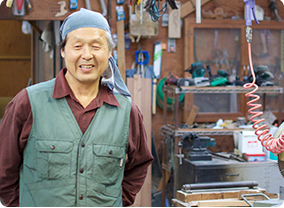Various techniques are required to make shrines. Simple shape shrines can be made by drawings and wood processing technique. If customer wants copper plate roof, copper plate processing technique is required. Some may want patterns of something drawn, some may want red shrines. In this case, painting technique is required. Thus products are made through various techniques combined.
Originally I worked for a manufacturer engaged in making bathes of Japanese cypress. My father was a carpenter. Because of these factors, I had archtectural and wood processing techniques. However, sheet metal work was out of my speciality. I felt ashamed as a craftsman to say that I didn't have technologies and couldn't make it. Accordingly, I learnt sheet metal work and basic matters pertaining to painting from my friends respectively. It is not a shame to learn unknown things from experts. Insufficient techniques may be filled up through experience. Each technique may be combined according to necessity.
I make universal pothooks which are used being hung above hearthes. The hook is used in such a way as hanging a pot or a pan when boiling water and other things. It can be moved up and down, working not only as a hanger but also as a tool to adjust distance againt fire since it is difficult to adjust thermal power in the hearth. ATELIER Daigoro make the hook also one by one using the material I find.
A hard time is to find bamboo pieces suitable for the hook column. I get fine roots good for the purpose digging the bamboo thicket and the mountain forest owned by my acquaintance who kindly let me do so. However this is quite a hard time for me because of the underground stem. Fine roots of bamboo and other trees get entangled each other. Digging is made avoiding obstacles. It takes 2 ~ 3 hours to get a thick piece. Even I thought a hole of 30cm depth was quite enough, a hole of 1m depth was finally made without my knowing in many cases. I get bamboo pieces having an image of fantastic finish this way or that way. Things can't be done without loving the job.
The bamboo pieces I've got by digging are dried for 5 years. Cracks come out on some pieces while being dried. This is a natural art, too. I have fun and a difficulty as well in doing this job which makes me realize that no same thing is manufactured. Even though drying is over, it doen't mean that the piece is combined with other and that a final product is obtained. A fish, which is the main piece of the hook, must be carved from raw timber of a camphor tree or a magnolia tree one by one. A lot of works and technique are incorporated to get a finished product.
The products handled by ATELIER Daigoro is all made to order. Products must be made in accordance with customers' requirements. There is a high grade product, too, for which it takes more than 1 month for completion dependant on the type of product. Therefore I tackle with all items with sincerety so that customers may be able to enjoy them for a long time.
The hearth warms even the inside of our hearts with charcoal soft fire. The color of universal pothooh changes because of fumigation over the hearth every day. The shrines installed in the main house marks the passage of time and keeps a very close watch on the house. The more it is used for tens of years, the more it develops its character. They are not of merely a consumable one. I will continue providing wonderful handmade articles.

HEAD OF "ATELIER Daigoro" FOR HEARTH, UNIVERSAL POTHOOK, "HIDANA" (FIRE RACK)
He is engaged in making Japanese traditional buildings such as shrines, hearthes, universal pothooks, etc., making good use of wood processing technique attained through carpenter works. Structures made through technical combination of wood processing, sheet metal work, painting and/or sculpturing also available.